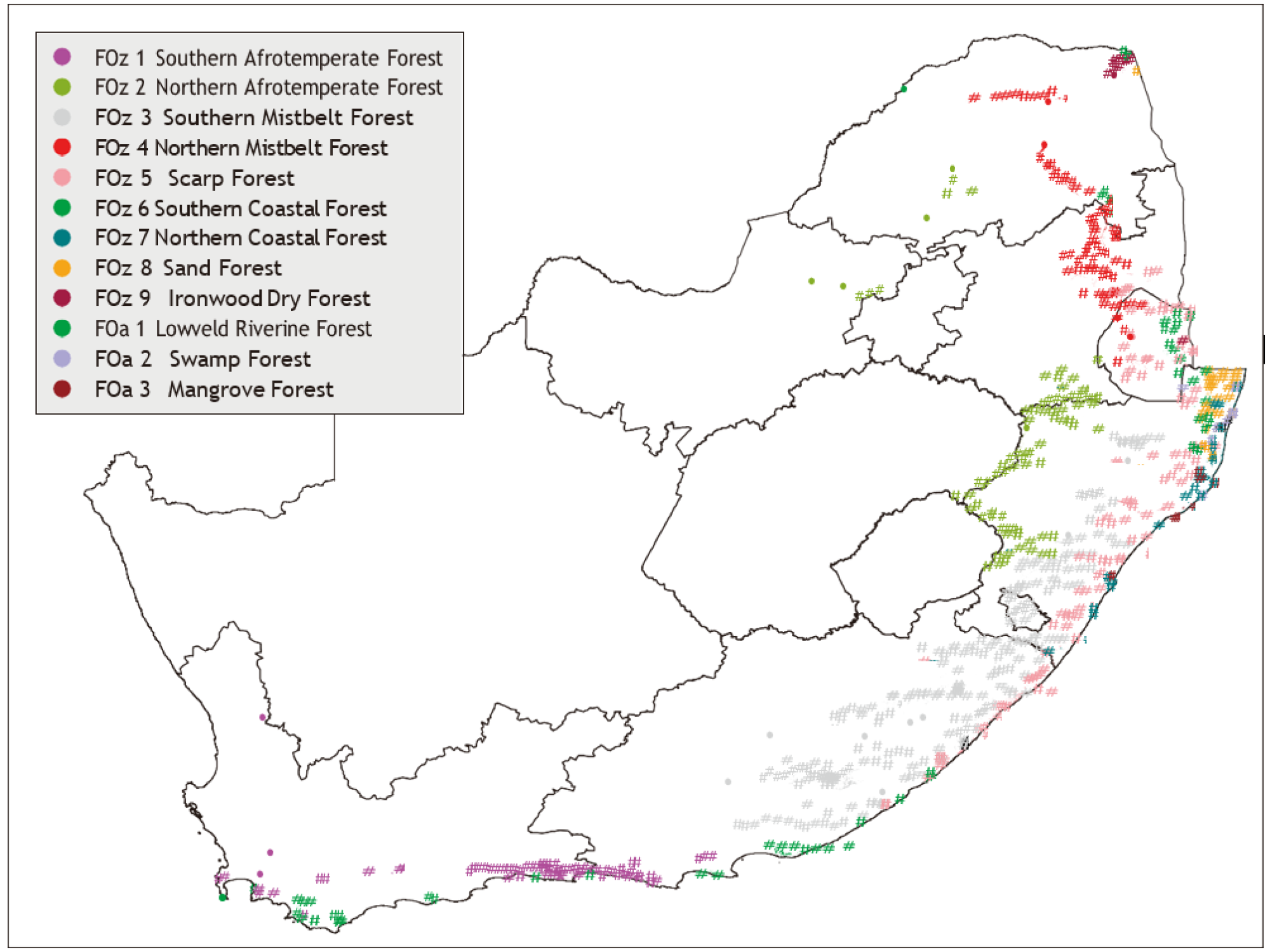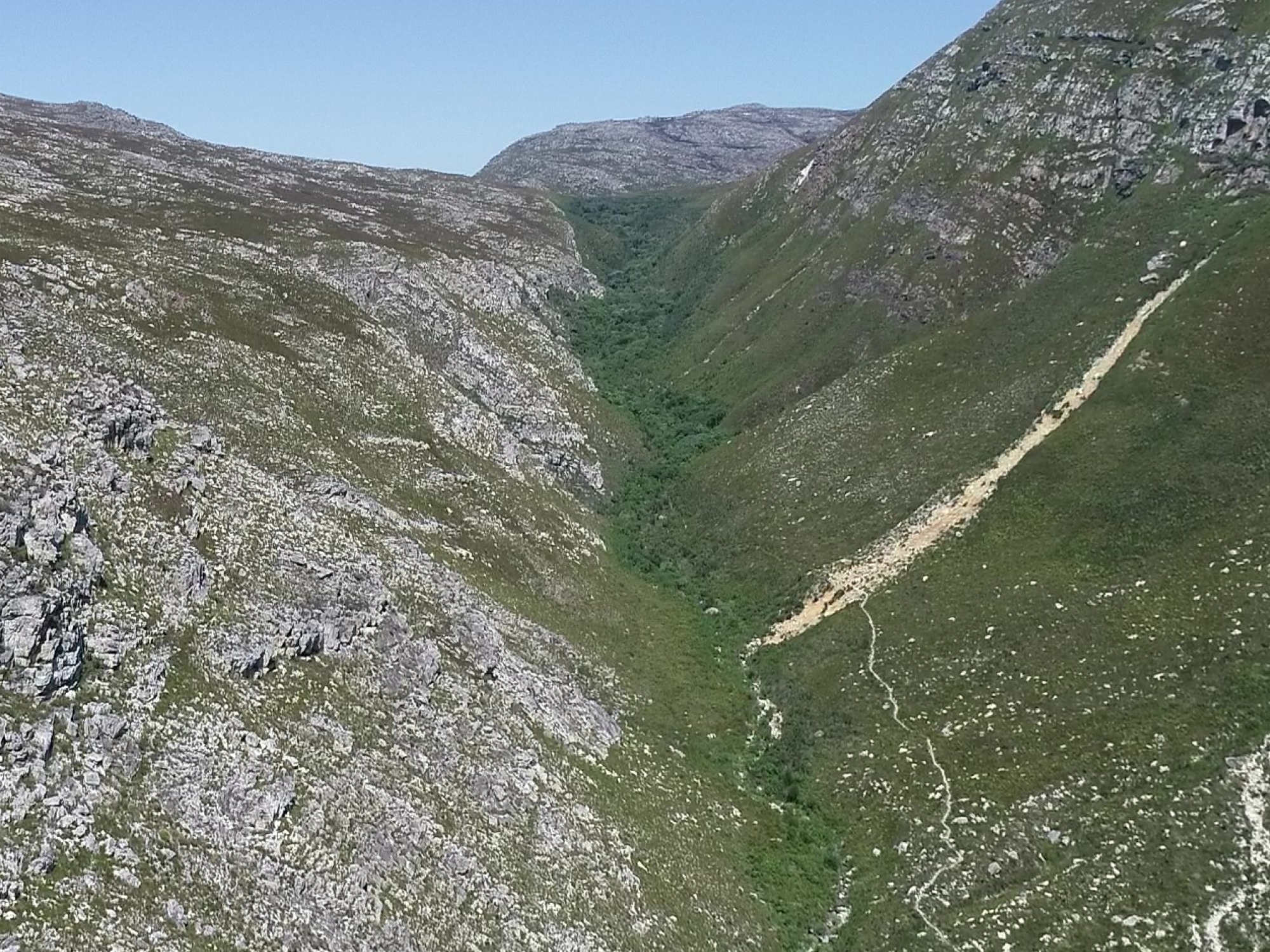Indigenous Forests of the Western Cape
It is a well-known fact that indigenous forests are vegetation units dominated by trees. A lesser-known fact is that graminoids (grass-like plants including grasses, sedges, and rushes) are generally rare within the herbaceous layer underneath the forest trees. With this in mind, it becomes important to note the difference between forest and woody savanna. Savanna woodlands have a grassy understorey which is often dominant. Furthermore, in forests, the crowns of trees overlap in at least one of the tree layers, whereas in savanna, the crowns of trees do not overlap (Mucina et al. 2022).
All indigenous forests of South Africa are evergreen. The largest expanses of these forests occur in the coastal provinces, excluding the coastline of the Northern Cape. The provinces of Mpumalanga and Limpopo also contain forests, with some small patches in North West Province (Figure 1).
Indigenous forests only cover 0.56% of South Africa’s landmass. In the diverse array of ecosystems found within the country, only a very small portion provides the essential ecological conditions to sustain indigenous forests. Forests have the potential for climate change mitigation through carbon storage which has placed an increasing global focus on forests in view of the escalating climate change dialogue (https://botanicalsociety.org.za/forests-of-south-africa/).
Southern Africa is home to three zonal forest types, namely Subtropical Forest, Tropical Dry Forest, and Afrotemperate Forest (Mucina et al. 2022). Mucina et al. (2006) identify 12 different vegetation units that are included in the country’s indigenous forests. Of these, only two units occur in the Western Cape, namely Southern Afrotemperate Forest, and Southern Coastal Forest. Southern Afrotemperate Forest usually occupies ravines and gorges in mountainous areas where it is sheltered from wildfires (Figure 2), however, severe fires could burn and damage the forest margins (Prader et al. 2023). Forest will rarely burn, only with exceptionally high temperatures and windspeeds or drought.
The largest extent of these forests occurs along the coastal strip of the southern Cape, from Mossel Bay to Humansdorp (Figure 3). The northernmost localities are near Vanrhynsdorp and the Matsikamma Mountains. Southern Coastal Forests occur within both the Eastern and Western Cape Provinces, including coastal dune systems. The westernmost type is the Western Cape Milkwood Forest (Mucina et al. 2006), which are dominated by Milkwood trees (Sideroxylon inerme) (https://botanicalsociety.org.za/forests-of-south-africa/). Both Southern Afrotemperate Forest and Southern Coastal Forest are listed as Least Threatened.
Afrotemperate Forest is usually tall and multi-layered and is dominated by yellowwood trees (Afrocarpus falcatus – Outeniqua Yellowwood or Outeniqua Geelhout; and Podocarpus latifolius - Broad-leaved Yellowwood or Kaapse Geelhout). Species of the Podocarpaceae (e.g., Afrocarpus and Podocarpus) are one of the few gymnosperms that inhabit tropical forests in the Southern Hemisphere. (Twala et al. 2023).
A recently published study (Lu et al. 2022) explains an interesting finding about how boundaries between different biomes are maintained. In the past it was believed that biomes were delineated primarily by extrinsic factors such as climate, geology and topography. The study confirmed that root traits and below-ground resource competition, along with fire history, could play a significant role in maintaining the sharp boundaries between the Fynbos and Afrotemperate Forest biomes.
Indigenous forests are magical spaces. The well-respected writer, Dalene Matthee, said “One should never enter the forest with a negative attitude”. According to lore, the Afrotemperate Forest of the southern Cape is home to the mystical forest elephants. Presumably these elephants are still living quietly and secretly in the forest but are very rarely encountered. In 2000, a forest guard photographed a young elephant bull from a distance of about 30 m. (https://www.knysnamuseums.co.za/pages/the-knysna-elephants/). Since then, remote cameras have captured a lone elephant matriarch, referred to as Oupoot, on a regular basis. Incredibly, recently a wildlife photographer met the magnificent Oupoot in person. According to the photographer, “the elephant only showed herself for a brief moment before she ‘melted’ into the forest like a ghost” (Estelle Ellis, The Daily Maverick, 4 July 2023).
Although the indigenous forests of the Western Cape only cover a small fraction of the landscape, it plays an important role in providing ecosystem services and have high socio-economic value. In addition, forests are biodiversity treasures. Forests in general, but the Afrotemperate Forest of the southern Cape in specific, are important tourist attractions. It is therefore crucial to secure the inter-generational preservation of indigenous forests. Forest conservation contributes to maintaining critical natural processes as well as all components within the forest, including all floral and faunal taxa.
Keeping the global expanse of forests in mind, the late Mahatma Gandhi impressed upon the world the importance of looking after these intriguing places: “What we are doing to the forests of the world is but a mirror reflection of what we are doing to ourselves and to one another”.

Figure 1: Distribution of mapped vegetation units of the indigenous forests in South Africa and Swaziland (Mucina et al 2006).

Figure 2: Afrotemperate Forest of Kogelberg Nature Reserve (Mark Johns).
Figure 3: Afrotemperate forest at Grootvadersbosh Nature Reserve CapeNature.
REFERENCES:
Lu M, Bond WJ, Sheffer E, Cramer MD, West AG, Allsopp N, February EC, Chimphango S, Ma Z, Slingsby JA andHedin LO. 2022. Biome boundary maintained by intense belowground resource competition in world’s thinnest-rooted plant community. Proceedings of the National Academy of Sciences, 119(9):e2117514119.
Mucina L, Geldenhuys CJ, Rutherford MC, Powrie LW, Lötter MC, von Maltitz GP, Euston-Brown DI, Matthews WS, Dobson L and McKenzie B. 2006. Afrotemperate, subtropical and azonal forests. In: Mucina L, Rutherford MC, editors. The vegetation of South Africa, Lesotho and Swaziland. Pretoria (ZA): SANBI; p. 584–615.
Mucina L, Lötter MC, Rutherford MC, van Niekerk A, Macintyre PD, Tsakalos JL, Timberlake J, Adams JB, Riddin T and Mccarthy LK. 2022. Forest biomes of Southern Africa. New Zealand Journal of Botany, 60(4), pp.377-428. DOI: 10.1080/0028825X.2021.1960383.
Prader S, Gillson L, Chase BM and Hoffman MT. 2023. Late-Holocene fynbos-forest dynamics in Orange Kloof, Table Mountain National Park, South Africa. The Holocene, 33(5):592-604.
Twala TC, Fisher JT and Glennon KL. 2023. Projecting Podocarpaceae response to climate change: we are not out of the woods yet. AoB Plants, 15(4), p.plad034. DOI: 10.1093/aobpla/plad034.
How can I assist you today?
How can I assist you today?